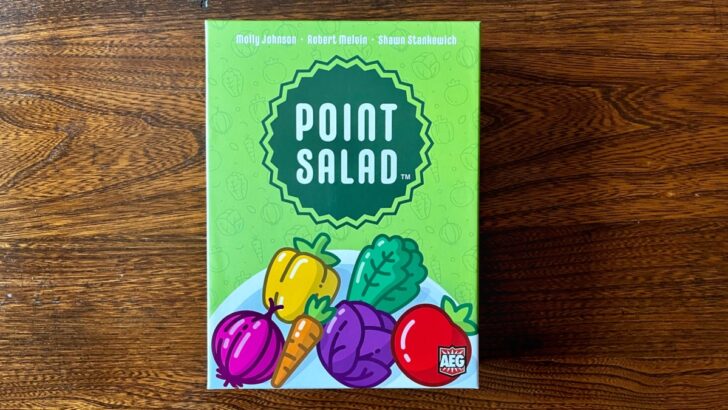Point Salad is a bright, colorful, and quick-playing card game that plays 2 to 6 players. Read our Point Salad review to learn more about this clever card drafting and tableau-building game.
Contents
Point Salad Overview
If you’re deep into the modern board gaming hobby, you’ve probably heard a game described as “point salad.” (This term has almost become synonymous with any Stefan Feld game.)
If you haven’t heard it before, a “point salad” game is one where points are waiting to be scored often and in several ways. Virtually every move you make will score you points and there’s usually not a single path to victory.
Designers Molly Johnson, Robert Melvin, and Shawn Stankewich took this popular board gaming term and developed a game around it.
Point Salad is both literally and figuratively just that, a point salad.
Players score points by drafting and collecting vegetable cards for their personal tableau while also deciding their own conditions for scoring their hoard of vegetables.
Point Salad Cards
The only component in Point Salad is a deck of 108 double-sided cards. These cards feature 1 of the 6 veggies in the game on one side and a scoring condition on the other.
(Going forward, we’ll refer to the vegetable side of a card as a “Veggie card” and the scoring condition side as a “Point card.”)
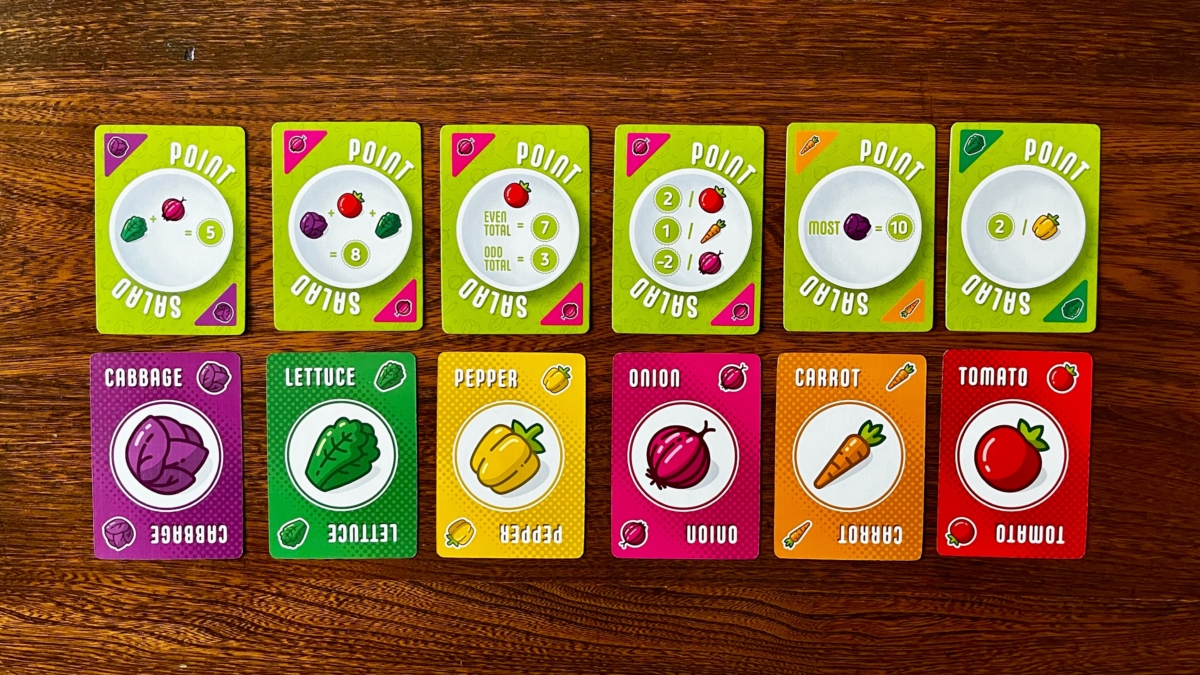
Pictured are the 6 different veggies in Point Salad (Cabbage, Lettuce, Pepper, Onion, Carrot, and Tomato) and some Point card examples.
Throughout the game, you’ll collect cards for either their veggie side or scoring condition.
How to Play Point Salad
Setup
The number of people you are playing with determines how many copies of each veggie will be in the game.
For example, in a 3-player game, 9 veggies of each type are used (54 cards in total).
These cards are divided into 3 equal piles with their Point sides facing up. From each pile, draw 2 cards and place them Veggie side up in a column below.
In this way, there should be 9 cards visible on the table: 6 Veggie cards and 3 draw piles of Point cards.
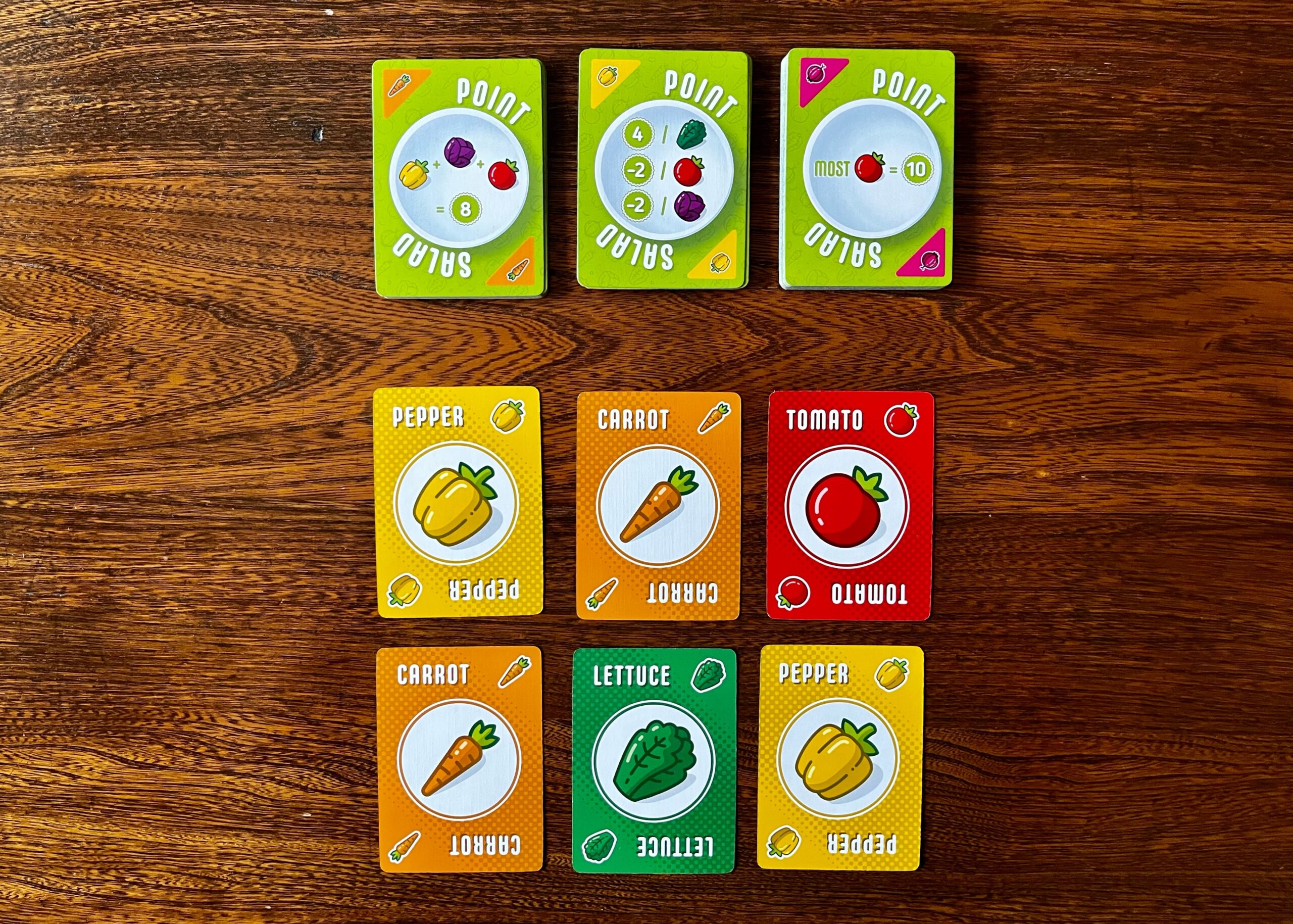
A game of Point Salad set up for 3 players. The Point card draw piles are above each column. The area with the 6 Veggie cards is known as the “Veggie Market.”
Player Turn
On your turn, you draft at least 1 card to add to your personal tableau, the area where you’ll be storing the cards you collect throughout the game.
Your drafting options are as follows:
- Take 1 Point card from the top of any draw pile, or
- Take any 2 Veggie cards from the market.
No matter which option you choose, you place your card(s) in front of you. At the beginning of the game, the first card(s) you add begin your tableau.
Additionally, on your turn, you may choose 1 of your Point cards to flip over and turn it into a Veggie card. (Two of the card’s corners show what veggie is on the other side of a Point card.)
This can only be done once per turn, and you may not turn Veggie cards into Point cards.
At the end of your turn, you refill the Vegetable Market, if necessary. This is done by drawing the top card from the pile above the column with an empty space and flipping it over to its Veggie side.
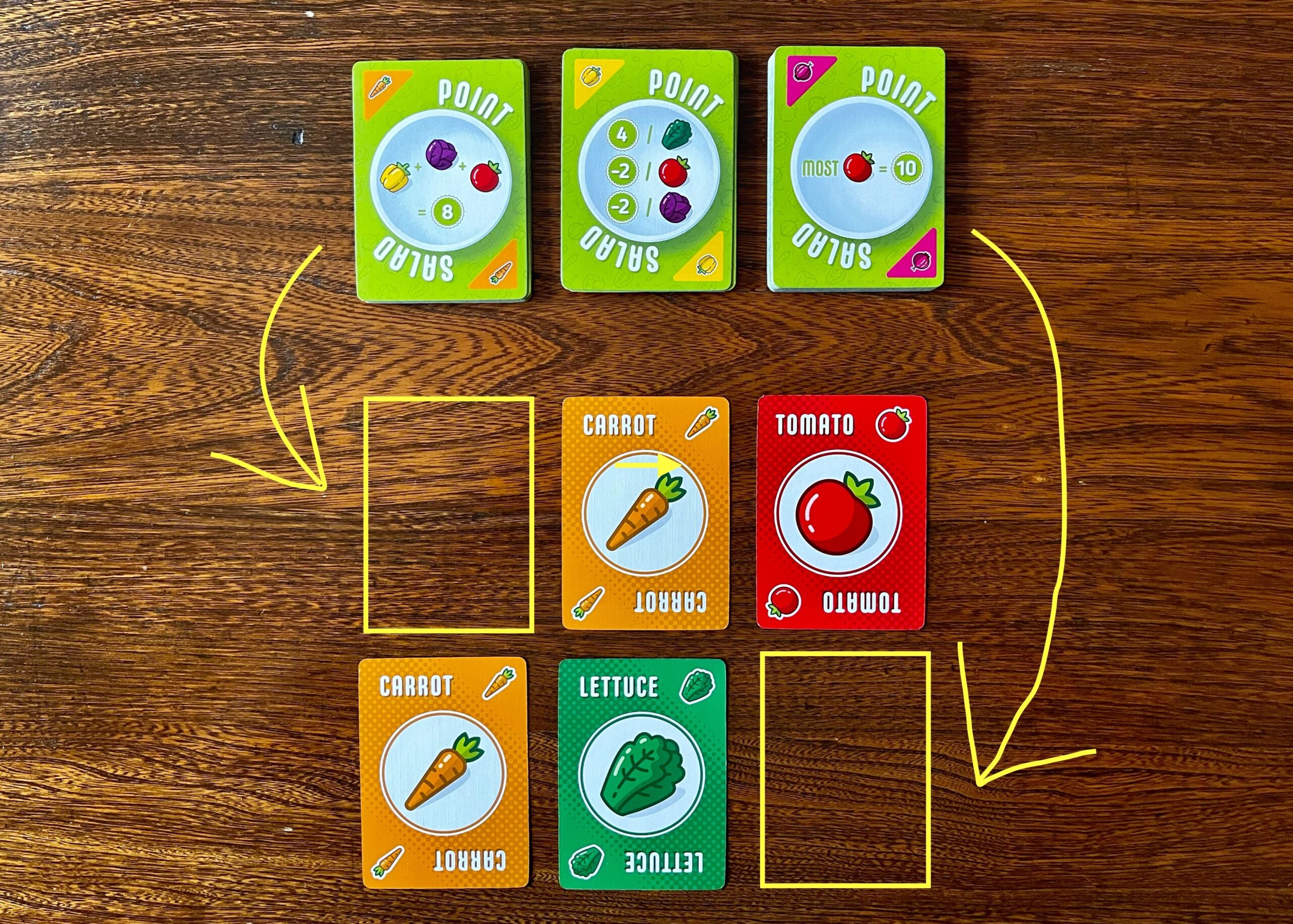
The leftmost and rightmost draw piles will refill the empty spaces in the Veggie Market.
Play then passes to the next player in clockwise order.
Game-end
The game ends when the players have drafted all the cards.
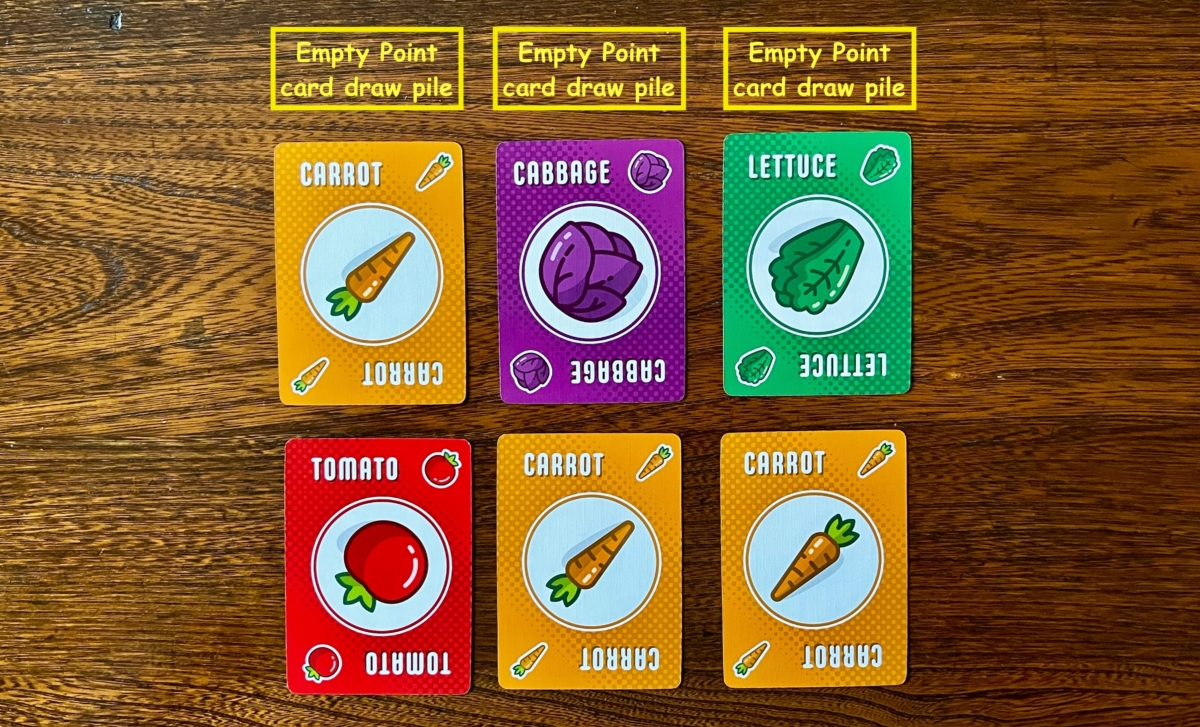
This game will end in 3 turns; on each turn, players must take 2 Veggie cards since no more Point cards are available.
Scoring
Each player scores points for their Veggies according to the conditions on the Point cards they drafted in the game. Each Point card can be scored multiple times and a Veggie card may be used to score multiple Point cards.
For instance, if you have a Point card that grants 2 points per Carrot and you have 4 Carrot cards, you will score 8 points.
These 4 Carrots could also be used to score your other Point card that awards 3 points per Carrot — scoring you another 12 points for a total of 20 Carrot points.
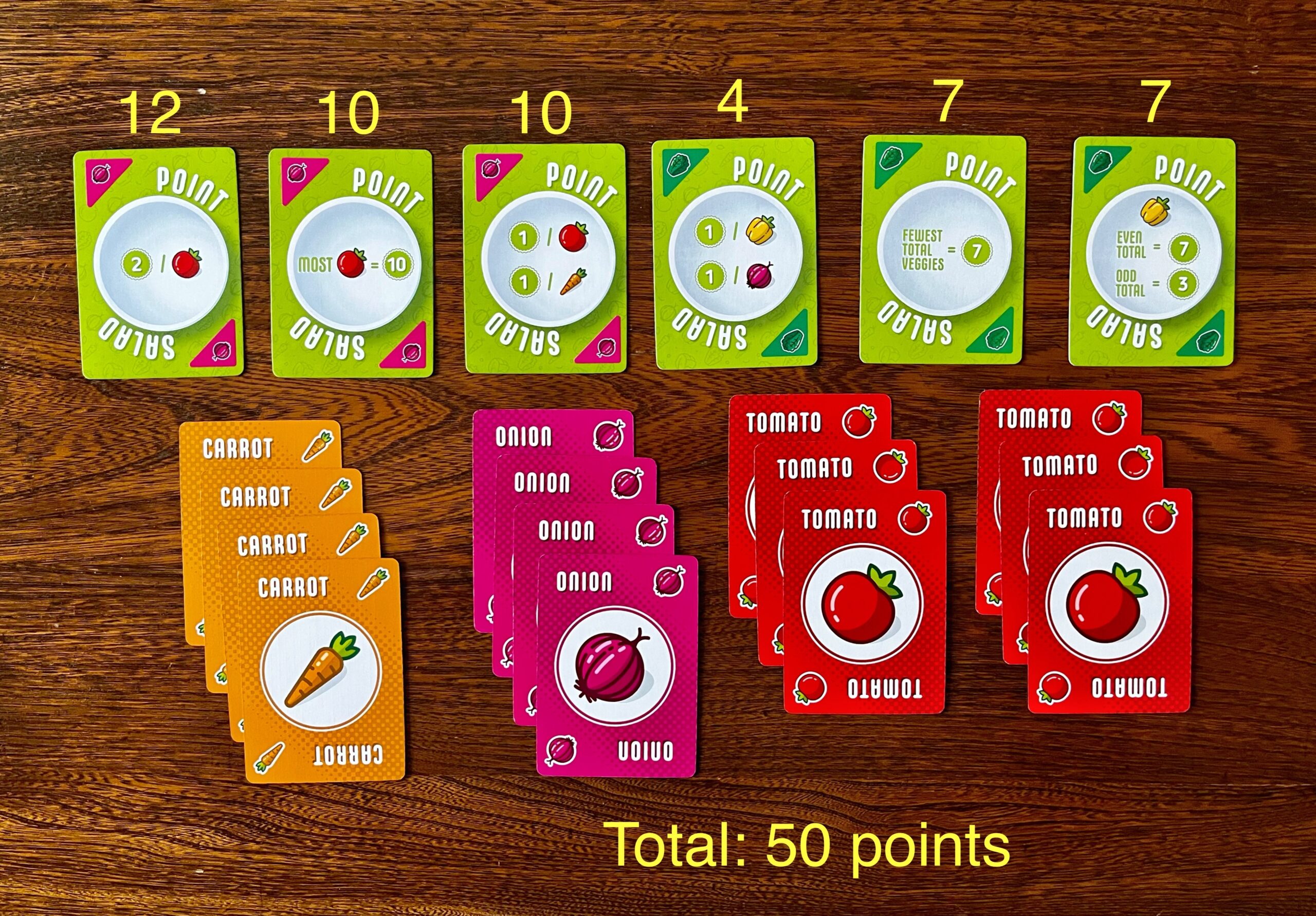
Here is an example of a player’s tableau at the end of the game. They scored 50 points.
Point Salad Review
Sometimes games with a simple ruleset don’t necessarily translate into elegant and thoughtful gaming experiences. Fortunately, Point Salad isn’t one of these games.
It may be a quick-playing game that takes mere minutes to learn, but it’s one that tickles your brain.
What makes Point Salad special is the sense of control it gives players; you choose how you want to score at the end of the game and which vegetables to collect along the way to achieve those goals.
Because the game’s initial state is so open, this gives you room to experiment with different strategies — and thankfully, there isn’t a single “correct” path to victory.
This also makes it difficult to know who is doing well in the game and how you’re faring.
This openness leaves room for thoughtful decision-making, with each turn feeling meaningful albeit a touch agonizing. (This is especially true when there are many excellent options on the table when your turn rolls around and you’re “forced” to pick from the best of the best.)
Point Salad scales well for the different player counts; the game is tightened up so that it doesn’t overstay its welcome and that decision-making tension is always present.
Will You Make Friends With (Point) Salad?
Point Salad isn’t necessarily a directly confrontational game — like, say, Uno is — but you will find that players indirectly mess with your plans time and again.
All too often, this could mean they hoard a specific kind of Veggie card that you need or take the Point card that would score your tableau perfectly.
In my experience, this is often unintentional; the Veggie or Point cards happen to work well with their strategy too.
(Occasionally, a player might draft a card out of spite, but it’s usually more advantageous in Point Salad to focus on what works best for your game and less on how to screw the rest of the players.)
Final Thoughts
Point Salad is a wonderful and quick-playing card game that provides a tense experience regardless of the player count.
If you’re looking for a perfect, stripped-back tableau-building game packed with thought-provoking choices, then Point Salad is the way to go.
You might also be interested in the following:

